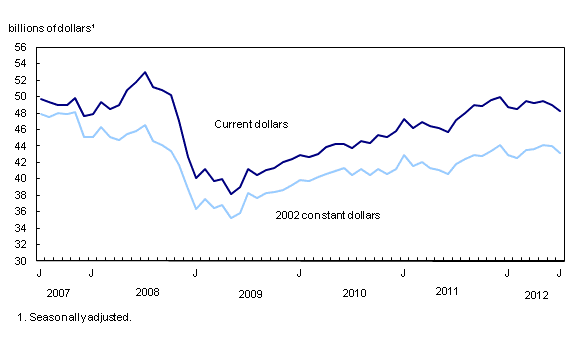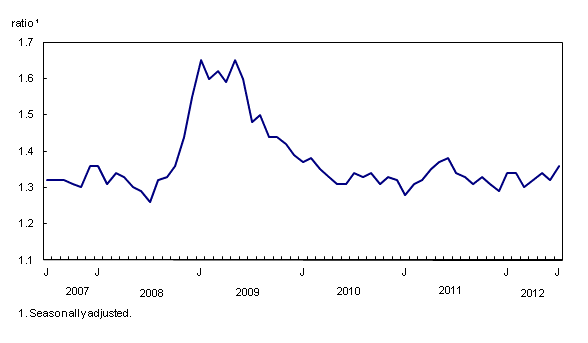Monthly Survey of Manufacturing, July 2012
Archived Content
Information identified as archived is provided for reference, research or recordkeeping purposes. It is not subject to the Government of Canada Web Standards and has not been altered or updated since it was archived. Please "contact us" to request a format other than those available.
Related subjects
-
[an error occurred while processing this directive]
Manufacturing sales fell 1.5% to $48.3 billion in July, the third decrease in five months. Declines in transportation equipment were largely responsible for the overall drop. Manufacturers in 11 of 21 industries reported lower sales, representing over 60% of total manufacturing.
Constant dollar sales decreased 2.0%. Sales of durable goods fell 2.7% while sales of non-durable goods edged down 0.1%.
Manufacturing sales decrease

Chart description: Manufacturing sales decrease
Transportation equipment loses traction after strong advances
Sales of transportation equipment fell 6.4% to $8.6 billion in July. The decrease follows four consecutive months of increases. A 22.1% drop in aerospace product and parts led the decline, followed by a 3.2% decrease in motor vehicle assembly.
Despite the decline in transportation equipment in July, manufacturers in this industry reported strong advances in the first half of 2012. Sales rose 17.8% compared with the first half of 2011. Higher sales in the motor vehicle assembly (+22.4%) and motor vehicle parts (+23.3%) industries drove the increase. In the first half of 2012, motor vehicle assembly was at its highest level since 2007, the year before the industry experienced a sharp downturn.
Lower sales of machinery equipment (-2.4%) also played a part in the overall drop. After reporting gains in June, manufacturers in the commercial and service machinery manufacturing industry reported lower sales in July.
Largest declines in Ontario and Quebec
Manufacturing sales declined in five provinces in July. Ontario and Quebec posted the largest decreases in dollar terms.
In Ontario, sales were down 1.9% to $22.3 billion. The decrease partly reflects a 3.0% decline in the motor vehicle assembly industry to $4.4 billion. Lower sales in the machinery (-6.6%), primary metals (-3.9%) and petroleum and coal product (-4.4%) industries also contributed to the provincial decline.
Manufacturing sales in Quebec decreased 2.6% to $11.3 billion, largely stemming from lower production in the aerospace product and parts industry. Aerospace production was down 45.1% to $569 million. Higher sales in the fabricated metal product industry partly offset the decline.
In Nova Scotia, sales were down 12.6% to $772 million, reflecting lower sales in the non-durable goods industries.
The largest provincial rise was posted by New Brunswick, where sales advanced 6.8% to $1.6 billion. The gain was mostly attributable to higher sales of non-durable goods.
Inventories rise
Inventories rose 1.0% in July to $65.5 billion, led by increases in the aerospace product and parts, and machinery industries. The aerospace product and parts industry posted a 7.4% increase to $4.9 billion, while inventories of machinery were up 2.8% to $6.9 billion.
Inventories in the computer and electronic product (+2.7%), motor vehicle (+7.1%), and wood product (+2.6%) industries also posted gains.
Decreases in inventories in the petroleum and coal products (-5.3%) and primary metal (-2.0%) industries partly offset the overall gain.
Inventories rise

Chart description: Inventories rise
The inventory-to-sales ratio increased from 1.32 in June to 1.36 in July. The inventory-to-sales ratio is a measure of the time, in months, that would be required to exhaust inventories if sales were to remain at their current level.
The inventory-to-sales ratio increases

Chart description: The inventory-to-sales ratio increases
Unfilled orders decline
Unfilled orders decreased 1.2% to $63.4 billion in July, following two months of gains. The decrease reflected lower unfilled orders in the aerospace product and parts, machinery, and fabricated metal product industries.
In the aerospace industry, unfilled orders declined 0.7% to $32.6 billion. The decline stemmed from an increase in the value of the Canadian dollar relative to the US dollar in July. A large portion of unfilled orders in this industry are in US dollars.
Unfilled orders in the machinery industry were down 2.3% to $8.1 billion, while those in the fabricated metal product industry fell 1.9% to $6.6 billion. In both industries, many manufacturers reported lower unfilled orders.
Unfilled orders decline

Chart description: Unfilled orders decline
New orders fell 5.6% in July to $47.5 billion, mainly reflecting a drop in orders in the aerospace product and parts industry.
Note to readers
The 2011 manufacturing review was released on August 3, 2012. The annual report Manufacturing: The Year 2011 in Review examines recent trends for sales by industry and other relevant variables related to manufacturing.
All data in this release are seasonally adjusted and are expressed in current dollars unless otherwise specified. For more information on seasonal adjustment, see Seasonal adjustment and identifying economic trends.
Preliminary data are provided for the current reference month. Revised data, based on late responses, are updated for the three previous months.
Non-durable goods industries include food, beverage and tobacco products, textile mills, textile product mills, clothing, leather and allied products, paper, printing and related support activities, petroleum and coal products, chemicals, and plastics and rubber products.
Durable goods industries include wood products, non-metallic mineral products, primary metal, fabricated metal products, machinery, computer and electronic products, electrical equipment, appliances and components, transportation equipment, furniture and related products and miscellaneous manufacturing.
Production-based industries
For the aerospace industry and shipbuilding industries, the value of production is used instead of sales of goods manufactured. This value is calculated by adjusting monthly sales of goods manufactured by the monthly change in inventories of goods in process and finished products manufactured.
Unfilled orders are a stock of orders that will contribute to future sales assuming that the orders are not cancelled.
New orders are those received whether sold in the current month or not. New orders are measured as the sum of sales for the current month plus the change in unfilled orders from the previous month to the current month.
Available without charge in CANSIM: tables CANSIM table304-0014, CANSIM table304-0015 and CANSIM table377-0008.
Definitions, data sources and methods: survey number survey number2101.
Data from the August Monthly Survey of Manufacturing will be released on October 16.
For further information, contact Statistics Canada's National Contact Centre (toll-free 1-800-263-1136; 613-951-8116; infostats@statcan.gc.ca).
To enquire about the concepts, methods or data quality of this release, contact Michael Schimpf (613-951-9832; michael.schimpf@statcan.gc.ca), Manufacturing and Energy Division.
- Date modified:
